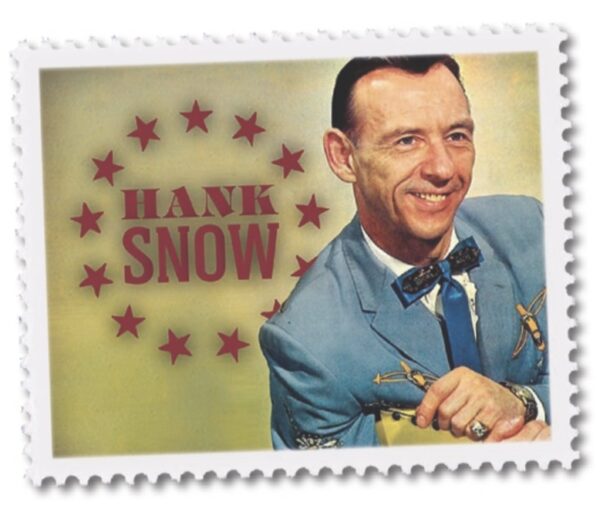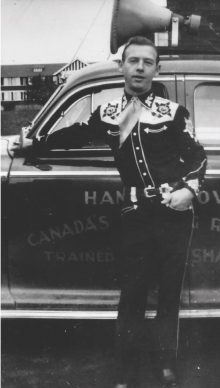The Singing Ranger ~ by Fred Hauck
When we think of singing cowboys, we think Gene Autry and Roy Rogers, and here in Canada, we add Wilf Carter (also known as Montana Slim) and Clarence Eugene Snow. If the name C.E. Snow doesn’t ring a bell, maybe his stage name of Hank Snow might.

Hank Snow was born May 9, 1914, in Brooklyn, Nova Scotia. When he was eight, his parents separated, and the local Overseer of the Poor removed the children from her home because of her inability to support them. One sister moved in with an aunt, the other two were sent to separate foster homes, and Snow himself went to live with his paternal grandmother, a cruel woman who ordered him never to mention his mother’s name and subjected him to severe beatings as well as psychological abuse. Snow would sneak away to visit his mother in nearby Liverpool and eventually, after his grandmother failed to get him sent to reform school, he was allowed to rejoin his mother.
At age 12 he went to sea as a cabin boy. Four years later, during a gale, the schooner was almost shipwrecked on Sable Island and that was the end of his fishing career. Having no home to go to, he spent many nights sleeping in the Liverpool train station.

One of his waterfront jobs was unloading salt. Hank purchased his first guitar — a $5.95 T. Eaton Special with his earnings. While in Nova Scotia he heard recordings of the “Old Blue Yodeler,” Jimmie Rodgers. Hank took an instant liking to the singer. Jimmie sang about trains, dressed as an engineer and the fact that he worked on railroads, got him the name The Singing Brakeman. Jimmie also did western songs and dressed as a cowboy. The cowboy image attracted Hank. He learned Jimmie’s songs but dressed the part in a 10-gallon hat and chaps.
His first radio job was at CHNS in Halifax. He was hired to do a daily radio show, and his theme song was Jimmie Rodgers’ “Yodelling Cowboy.”
A superb self-taught guitarist, Hank also taught lessons. While in Nova Scotia, he married his wife, Minnie, and they would remain married for 55 years. They soon had their only child, Jimmie Rodgers Snow, named after Hank’s idol.
In 1936, Hank made his first recording for Victor on the Bluebird label (later RCA Victor) in Montreal. The first two songs were “Lonesome Blue Yodel” and “The Prisoned Cowboy.” The name on the record was Hank, The Yodeling Ranger.
The recordings continued, and some became popular in Canada. Meanwhile, his voice deepened, and he could no longer yodel. RCA told Hank that he needed a new name, so he decided on “Hank the Singing Ranger.” This he kept until the end.
During this time, Hank bought a pinto horse he called Shawnee from Elmer Newman of Pennsylvania. The horse was partially trained, and Hank finished the training and went on the road with his young wife and son as part of the show. Hank bought a truck with a van body to haul Shawnee. The horse was a featured attraction, and his greatest trick featured Hank standing on the saddle spinning a lariat around the both of them, while Shawnee twirled a small lasso with his mouth.
Hank went to Dallas, Texas, and landed a spot on radio station KRLD. At the time, his hit was “Brand On My Heart.” While there he became friends with Ernest Tubb who told him that he needed to be on the Grand Ole Opry in Nashville. Ernest took some 78’s down to WSM Radio, and they gave Hank a shot on January 7, 1950. He sang “Brand On My Heart.” The crowd was not too receptive and Hank’s trial period was almost over when, as Hank had often said, “the good Lord guided my pen as I wrote, ‘I’m Movin’ On,’ and that saved the day.”
The song hit number 1 and stayed there for 21 weeks. This feat stayed unchallenged until another Canadian, Shania Twain, broke the record some 50 years later.
With Hank’s new success, he bought his first and only home in Maddison, Tenn., that he named Rainbow Ranch. Hank’s band was called “the Rainbow Ranch Boys” — both throwbacks again to Jimmie Rodgers. It had a barn for Shawnee and room to roam.

“I’m Moving On” was the first of Hank’s seven number-1 hits on the country charts. That same year “The Golden Rocket” and “Rhumba Boogie” both hit number 1. Along with these hits, his other signature song was “I’ve Been Everywhere.” Hank was hot, and he went on tour. In the early ’50s, Hank discovered Elvis and put him on his shows as his opening act.
During his career, Hank recorded 800 songs on 140 albums, which sold over 80 million copies and charted more than 85 singles on the Billboard country charts from 1950 until 1980. His number 1 hits include the self-penned songs “I’m Moving On,” “The Golden Rocket” and “Rhumba Boogie” plus famous versions of “I Don’t Hurt Anymore,” “Let Me Go, Lover,” “I’ve Been Everywhere” and “Hello Love.”
In 1978 he was elected to the Nashville Songwriters Hall of Fame, in 1979 to the Country Music Hall of Fame, the Canadian Music Hall of Fame and the Nova Scotia Music Hall of Fame. He was also inducted into the Canadian Country Music Hall of Fame in 1985. Today, the old Liverpool train station he slept in as a child is now a museum dedicated to Hank Snow.
His autobiography, The Hank Snow Story, was published in 1994, and later The Hank Snow Country Music Centre opened in Liverpool, Nova Scotia. A victim of child abuse, he established the Hank Snow International Foundation For Prevention Of Child Abuse.
In 2014, Canada Post issued a Hank Snow postage stamp.
Hank died Dec 20, 1999, and is buried in Nashville, Tennessee. He was 85 years old.
















